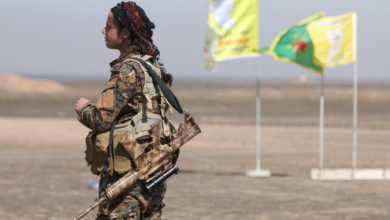
The erratic ISIS and Baath party connection
The reported death, yet to be confirmed, of the King of Clubs, Izzat Ibrahim al-Douri, in the notorious U.S. most-wanted Iraqi playing cards, is bringing in to sharp relief the issue of the Baathist factor in the Islamic State of Iraq and Syria (ISIS) or ISIS.
Baathism, of course, has its roots all the way back to 1943. Baathism, or “renaissance” or “resurrection” is an anti-colonial and pan-Arabist doctrine. At the time, being a Baathist, meant to claim a pure blood lineage to the origins of Islam and, at the same time, invoke the mid–twentieth century ideals of socialism. Baathism called for the rejection of the “Western civilization’s invasion of the Arab mind.” Sound familiar?
What followed, of course, was the fusion with socialist ideology compounded by nationalism. Later, Baathists seemed to be returning to their roots by attempting to restore their power through a number of different tracks over the past decade: secularism, insurgency, and terrorism.
That Baathists helped ISIS, before the declaration of the ‘Caliphate,’ to rush into Iraq last year, and assist in the battles for key nodes in Iraq, is indisputable. Even in the Second Battle of Tikrit, just fought in the past few weeks, Baathists were a prominent component of ISIS forces. The very fact that Saddam Hussein’s al-Tikriti tribe was tossed out of their tribal domain certainly bore the hallmarks of the ultimate revenge against the Baathist core.
Military maneuvers
Iraqi Baathists, who went underground following the collapse of Saddam Hussein’s government in 2003, clearly never were put on the ash heap of history. These Baathists, engrained with an ideology with tribal and Sunni attributes, bided their time, seeing greater and more repugnant treatment by the Shiite government in Baghdad under former Iraqi Prime Minister Nouri al-Maliki.
The Baathist Factor in ISIS is not static: It is erratic, wavering, self-serving, and, most important, amorphous
Dr. Theodore Karasik
The complex mosaic that is Iraq helped them create the insurgency, al-Qaeda in Mesopotamia or al-Qaeda in Iraq (AQI), which is now seen today as ISIS. Ramadi seems to be next on their list as thousands flee. It is notable that the Baathist factor is never ending, it seems, taking two steps forward, and two steps backwards, despite the U.S.-led coalition airstrikes and the relentless fighting of the Iraqi security forces including the Al-Hashd al-Sha‘b, also known as the Popular Mobilization Units, the Shiite militias and the Kurdish Peshmerga.
It is reasonable to gather that Iraqi Baathists have been and are helping ISIS with military tactics, techniques, and procedures (TTPs). These skills are being mixed with the Chechen military terrorist influence in ISIS and there is little doubt that the nexus between the two makes for robust battle TTPs. In addition, top Baathists, at the beginning of ISIS included former Iraqi officers like Fadel al-Hayali, the top deputy for Iraq, who once served Saddam Hussein as a lieutenant colonel, and Adnan al-Sweidawi, a former lieutenant colonel who headed the group’s military council. ISIS leader Abu Bakr al-Baghdadi had allegedly sought to win thesupport and loyalty of both men, as well as other experienced former Iraqi army officers, from very early on.
Division line
But we should not put Iraqi Baathists and ISIS always in the same basket. The Baathist Jaysh Rijal al-Tariqa al-Naqshibandi (JRTN) or the Army of the Men of the Naqshbandi Order, actually predate ISIS as they were formed in 2007 by Baathists in the wake of Saddam Hussein’s execution during Eid Al-Adha, which was seen as the ultimate insult by the Shiite Baghdad government against the former Sunni regime. There are clashes between the two groups that have resulted in executions and infighting over the last year. The division line between the two groups becomes sharpest after the battlefield shifts and personal scores or religio-political and tribal disputes and retribution need to be settled. In other words, the Baathist Factor in ISIS is not static: It is erratic, wavering, self-serving, and, most important, amorphous.
Baathists are, by nature, anti-Kurd and anti-Persian, and anti-Shiite. Their thirty-five years in power in Iraq helped to create several generations of ideologically-driven, tribal and family networks that found themselves in bed with the violent extremists of ISIS. The Baathist cult of violence fits neatly into ISIS’s criminal violence augmented now by social media. Imagine for a moment if Iraqi Baathists had demonstrated heavy public use Twitter or other platforms. Perhaps the resulting shock and psychological productions would be the same.
But violence begets violence, and the Baathist factor in ISIS will erupt from time to time, in viciousness, but also in unity, when it is expedient. Losing top Baathists leaders do not kill a generational mindset. Thus, the idea that Iraq may not be unified any time soon is highly likely because until time passes, political reforms are introduced by Baghdad, and ISIS is pushed out of the fragmented country, the Baathist Factor will remain a menace.
Dr. Theodore Karasik
Alarabiya



